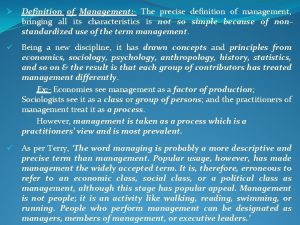Introduction to Marketing Management Definition of Marketing l













- Slides: 13

Introduction to Marketing Management


Definition of Marketing l l l Marketing is the activity, set of institutions, and processes for creating, communicating, delivering, and exchanging offerings that have value for customers, clients, partners, and society at large. (Approved October 2007, AMA) Marketing is meeting needs profitably. Marketing management is the art and science of choosing target markets and getting, keeping, and growing customers through creating, delivering, and communicating superior customer value.

Focus of this Course l l Marketing philosophy and customer relationship management Consumer behavior l l l STP l l External, e. g. observation, data mining. Internal, e. g. cognition, attitude, and decision making. Segmentation, targeting, and positioning Marketing strategies l Product, price, place, and promotion

STP concept l l Market segmentation: dividing a market into distinct groups of buyers who have distinct needs, characteristics, or behavior and who might require separate products or marketing mix. Steps for market segmentation l l l Identify bases (ex. geographic, demographic, psychographic, and behavior) of segmenting Develop profiles of resulting segments Market segment: a group of consumers who respond in a similar way to a given set of marketing efforts.

Case: 統一泡麵 1970 1978 1983 1991 1999 1989 2006

STP concept l l Target marketing: the process of evaluating each market segment’s attractiveness and selecting one or more segments to enter. Steps for target marketing l l l Evaluate the attractiveness of each segment Select the target segments A company with limited resources might decide to serve only one or a few special segments or “market niches”. l E. g. Arm & Hammer, Oshkosh Truck, and Veterinary Pet Insurance.

Case: Veterinary Pet Insurance l Facts l l l More than 60% of all U. S. households own one dog or one cat or both. There are more than 60 million dogs, 68 million cats, and 2 million rabbits in U. S. . Spend $28. 5 billion a year on the pets. Nearly 75% of pet owners are willing to go into debt to pay for veterinary care. Sales have grown 40% in each of the past year, reaching nearly $72 million last year.

STP Concept l l Market positioning: arranging for a product to occupy a clear, distinctive, and desirable place relative to competing products in the minds of target consumers. Steps for market positioning l l l Identify possible positioning concepts for each target segment Develop marketing mix for each target segment Examples: HITACHI, KOLIN, and SAMPO.

The 4 P’s of the Marketing Mix



Case: Fitness First
 Marketing management definition
Marketing management definition Characteristics of strategic marketing
Characteristics of strategic marketing Marketing meaning in marketing management
Marketing meaning in marketing management What is marketing management
What is marketing management New market realities
New market realities Top management and middle management
Top management and middle management Top management middle management first line management
Top management middle management first line management Basic concepts of management
Basic concepts of management Definition of information system
Definition of information system Marketing information management
Marketing information management Define marketing
Define marketing Marketing info management definition
Marketing info management definition Market management definition
Market management definition Marketing concepts
Marketing concepts
























